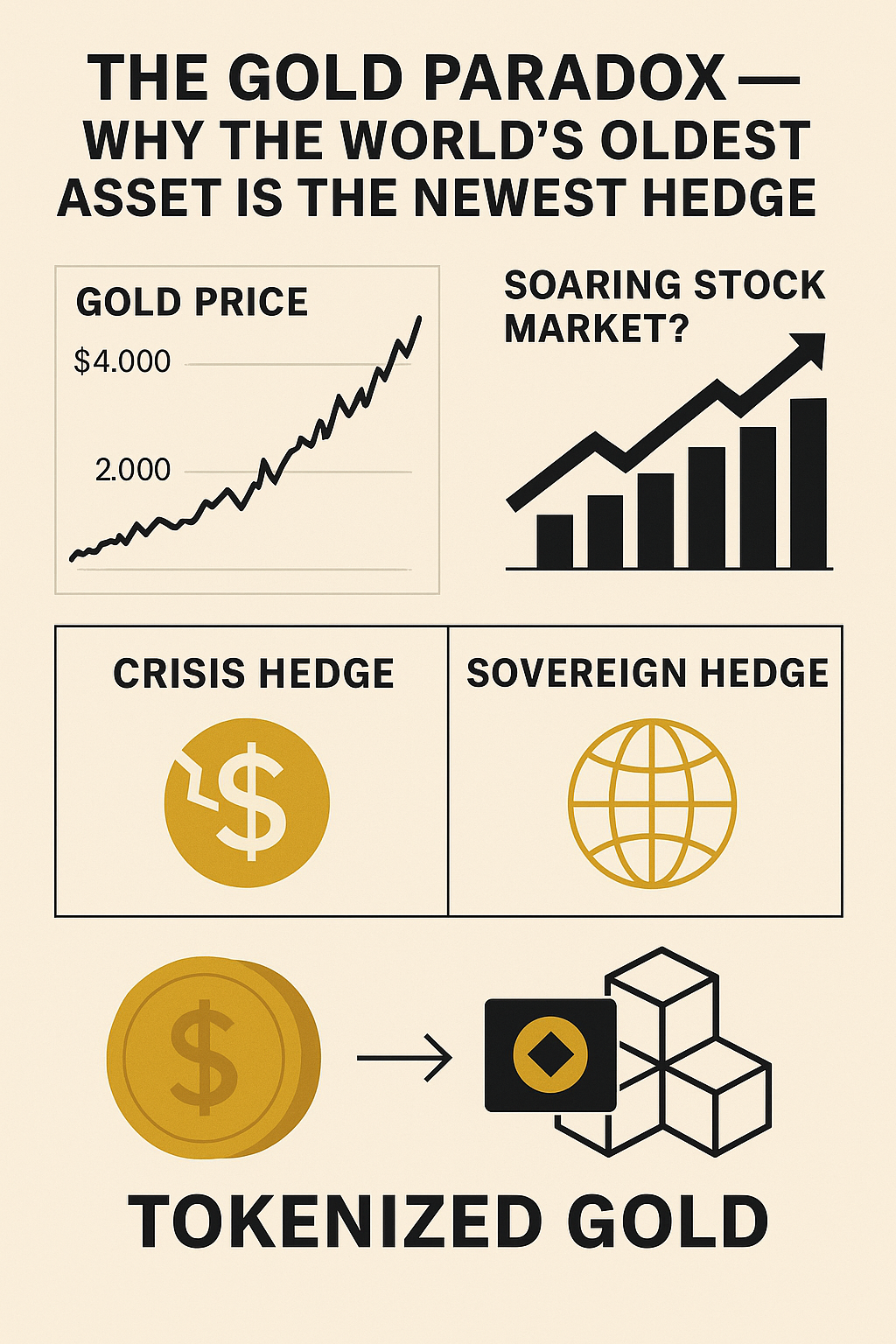Gold has hit $4,000 an ounce — a milestone that feels less like a spike and more like a signal. The paradox? Stocks are at record highs, bond yields are stable, and the dollar isn’t collapsing. Traditionally, those conditions keep gold prices in check. Yet here we are, watching the metal surge while Wall Street celebrates and policymakers insist everything’s fine.
Something deeper is happening.
Gold Has Stopped Responding to Fear — It’s Responding to Distrust
For half a century, gold has been the panic button. When markets trembled, investors grabbed gold bars and waited for the dust to settle. But this rally is different. There’s no visible panic. The volatility is philosophical, not financial. Investors aren’t reacting to bad headlines — they’re anticipating a slow erosion of faith.
Ray Dalio said this week that gold is now safer than the U.S. dollar. He’s not alone. Central banks across Asia, the Middle East, and Africa have been stockpiling bullion at a pace unseen since the 1960s. They aren’t buying because they expect hyperinflation tomorrow; they’re buying because they’ve seen what happens when dollar reserves can be frozen with a single sanction.
In other words, gold isn’t just a hedge against recession anymore — it’s a hedge against the system itself.
The Shift: From Crisis Hedge to Sovereign Hedge
When the U.S. and its allies locked Russia out of its dollar reserves in 2022, the world learned an uncomfortable truth: money is only yours if your politics are approved. Since then, countries from China to Saudi Arabia have been quietly rebalancing. They’re not dumping dollars — they’re diversifying trust.
Gold has become the neutral reserve in a world of weaponized currencies. It doesn’t need a counterparty. It doesn’t rely on faith in Washington or Brussels. It’s old-school collateral for a post-trust economy.
And it’s not just nations doing this. Pension funds, hedge funds, and private investors are joining the movement. Morgan Stanley recently proposed a 60/20/20 portfolio split: stocks, bonds, and gold — equal weight between Treasuries and bullion. That’s a profound statement. It says gold, not U.S. debt, is now the ultimate “risk-free” asset.
AI and the Illusion of Prosperity
The stock market’s AI-driven boom feels like the mirror opposite of gold’s rise. Silicon Valley sells infinite scalability; gold represents finite reality. Yet both are drawing capital because they speak to the same insecurity — that traditional finance is hollowed out by debt and politics.
Investors are hedging the two extremes of belief:
- AI represents faith in technology to replace productivity.
- Gold represents doubt that the system built on that faith will last.
Both are rational. Both are expressions of the same nervous genius that built markets and empires alike — the instinct to hedge against our own optimism.
The Emerging Synthesis: Tokenized Gold and Digital Trust
The bridge between these worlds is already being built. Tokenization — the process of representing real-world assets on the blockchain — lets gold behave like a 21st-century asset without losing its ancient gravity. A tokenized gold reserve can move across borders instantly, audited in real time, yet still backed by something no algorithm can counterfeit.
Projects like the Afro Gold Dollar and similar RWA-backed stablecoins represent this synthesis: tangible value meeting digital efficiency. They’re not replacing fiat — they’re insulating wealth from fiat’s fragility.
If the 1970s were about inflation, and the 2000s were about innovation, the 2020s are about integration. AI, blockchain, and commodities are converging into a new financial architecture — one that prizes resilience over rhetoric.
The Takeaway
This isn’t just a gold rally. It’s a trust rally.
Gold at $4,000 isn’t signaling panic — it’s signaling preparation. Investors aren’t betting on collapse; they’re positioning for transition. From dollar hegemony to multi-polar reserves. From fiat illusion to asset-backed reality. From passive portfolios to active sovereignty.
In the coming years, the world’s wealth won’t just be stored in vaults or data centers — it will live at the intersection of both. The winners will be those who understand that gold is not an ancient relic, but a modern protocol for stability.
Because when the world pretends everything’s fine, gold quietly reminds us it’s not — and that’s exactly why it shines.

Leave a Reply